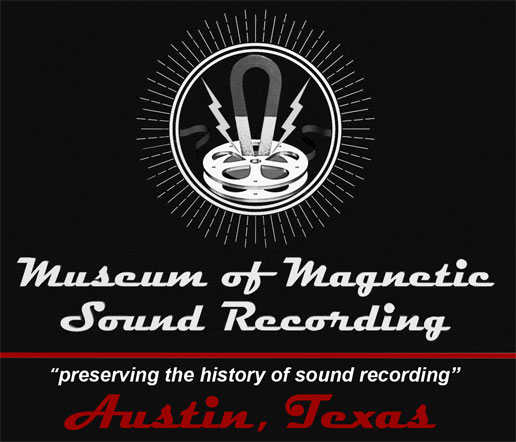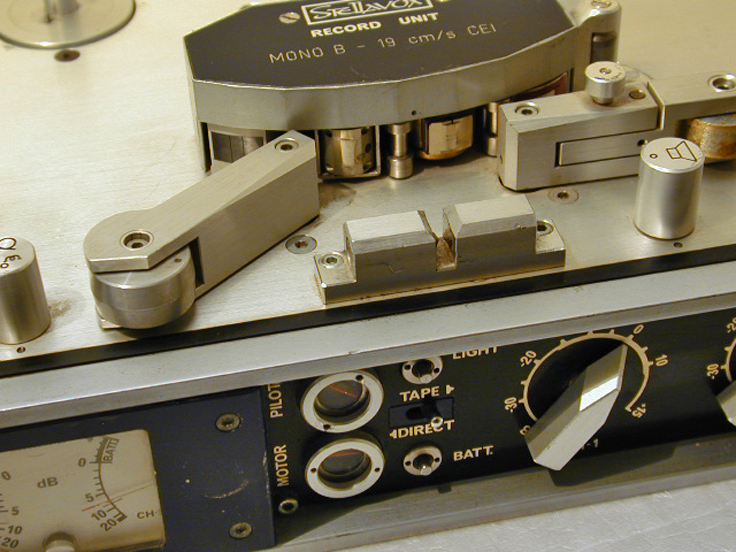
Stellavox

PLEASE NOTE: None of the Vintage Museum items are for sale.
News coverage #1 News coverage #2 • view overview video of tape recorder collection • mobile video • more info
Interviews and StoriesPreserving the stories of significant individuals in sound recording generally and magnetic recording specifically is a major project of MOMSR. The Museum’s goal is to document the stories of those persons who contributed significant inventions, manufactured equipment and who engineered and produced audio recordings, especially in the areas of music, broadcast, film/video and science. These interviews will be available on MOMSR’s web site and in the permanent facility when it is created. These interviews have also been made available to the Audio Engineering Society (AES) and the National Academy of Recording Arts and Sciences (Grammy’s).
The Museum of Magnetic Sound Recording greatly appreciates Kostas Metaxas providing us with the following information, as well as his video interview with Stellvox's founder Georges Quellet.
I purchased my first "reel to reel" directly from Georges Quellet in Hauterive, Switzerland in 1986.
At the time, I was using 3 Goldmund Turntables [2 Studios and a Reference with T3 arm and Clearaudio cartridge] as my audio references, but as soon as I recorded my first concert with the portable Stellamaster and a pair of B&K4133 microphones, that was it for me. The difference in sound quality was dramatic. The tape machine produced a much bigger, deeper and far more realistic sound than I was able to obtain with LPs on a turntable. I dabbled with recording over the years, but it wasn't until the end of 2003 when I returned to Australia after a brief stint in NY and then London, that I decided to take things more seriously.
Interview with Georges Quellet in 2006
The recordings you will hear are produced as a joint project with very gifted local and international performers including Tim Ries [Rolling Stones], James Morrison, Pascal Schumacher. Fritz Hauser, Il Giardino Armonico, Takacs, St Lawrence Quartet [Musica Viva], ACO, Australian Opera and many others.
Since early 2004, I've recorded over 200 concerts and used my 30 years of playback system design experience to make incremental adjustments to my recording equipment and chain to produce the most natural sounding acoustic recordings in a natural acoustic space.
Equipment:
Microphones - 1 pair Neumann M150 [valve], 1 pair Neumann TLM50s "titanium",1 pair Neumann TLM50s "nickel" , 2 pairs B&K 4135s, 2 pairs Gefell MK301s, 2 pair B&K 4133s, Gefell M296 pair
Cables - Metaxas ENOSIS , Van Den Hul MIC Hybrid, Mogami 2534 Neglex, Gotham
Mic Pre's/Mixers - Metaxas GQT and Stellavox AMI48 [Metaxas-modified]
Tape Recorders - modified Stellamaster SM8, Stellavox SU8, Stellavox TD9 [1/4" & 1/2" tape]
Digital Back up - Metaxas "WOLF" ADC [24b/96k using Wolfson ADC and proprietory circuit/clock] with ENOSSIS digital link to SPDIF input of Sound Devices SD744T[4-channel] & 722[stereo] as "storage".
How it began...
I'm sure that every Audiophile has at least thought about recording a bit of live music, and even some have dreamt about becoming a recording engineer - and I'm certainly one of those.
Unless you want to record a neighbour's 10 year old practicing "badly", actually having a musician allow you to record their music is quite daunting. Mostly, because musicians are quite suspicious, so my first attempts were met with a mixture of reactions.
My early years were filled with "these" sorts of experiences. Rehearsals in poky rooms, gigs in smoke-filled hotels with PA's blaring. Lugging expensive equipment up flights of stairs to "demolition-ready" venues which had seen better days.
Once you've passed these off-putting experiences and manage to actually record a worthwhile concert, you encounter a different set of obstacles. From the politics of a gig
and dealing with performers, production managers, agents, lighting and sound reinforcement chappees, to the simple task of where you can set up . Then you need to get past equipment issues and problems, rain or strange noises coming from the air-conditioning ,planes flying over and car alarms sounding.
Then if you are really, really lucky, you get a glimpse of the "magic" .
When a concert is magic, there is no other way to describe the feeling other than heaven on earth. And sadly, it doesn't happen often enough.
You're only as good as your equipment…
I'm going to be a little controversial at this point. If your equipment is "exceptional", you are at least 90% towards creating a great recording.
It's actually the same with Hi-End Audio. An exceptional system somehow actually makes MORE recordings sound interesting and involving.
Because there is no equivalent to a Hi-End press in the professional recording world, you are really on your own when it comes to assembling a "reference quality" recording system. And there are only a few individuals who "we [Hi-End Audiophiles] " know who actually have some knowledge in this field.
The professional world doesn't share the same vocabulary of "soundstage width and depth", "tonal neutrality" and "transparency". In fact, most recording engineers [and there are very few exceptions ] pick their microphones and equipment for their "known" colorations. And the "sound" they tend to go for in general, is "dry" [they want to be able to ADD effects] and has no depth of field - because it is generally recorded in a poky studio.
My first recording in 1987 with my Stellavox SM8 and a pair of B&K 4133 mics proved to me that it could be the basis of a "reference" recording system. I made up my mind very early on to ignore the pro-industry approach to recording and instead focus on an almost Hi-End playback approach using the best recordings from the 60's as examples of what was possible - recordings from Bob Fine [Mercury], Ken Wilkinson [DECCA] and Lewis Layton [RCA], and of course a lot of experimenting during real recording sessions [mostly at the rehearsals].
The first experimentation was with microphones. Although I liked some of the colourations I could hear with AKGs, NEUMANNS, SCHOEPS etc, they were all adversely affecting the soundstage width and depth of a performance. I found that faster and smaller diaphragm microphones soundstaged better than the traditional 1" capsules of the more famous types. So I settled on a B&K 4133 which is predominantly used for lab testing. It was transparent enough that I could start to hear some of the limitations of the Stellavox SM8.
I have to congratulate Stellavox's Georges Quellet. He has picked his "compromises" well. But I don't think he ever knew how good his very simple two-stage single-ended, battery operated [13V] modules are. When I first heard them, I could tell from my first recordings that he had gotten their soundstaging properties right. All that was missing was issues with forming 3D images on that soundstage.
So the first thing I did was replace the ceramic caps he uses in the feedback loops, record and playback equalization with "blended" polystyrenes and solved that problem [adding quite a few extra "bits" to it].
I also bypassed/replaced the electrolytics in the signal path, rewired the signal path and the final huge improvement came with the substitution of a Lundahl [1538xl] mic transformer for the existing BEYER.
At this point, I could start to hear the improvement that the B&K 4135 made over the 4133 - a positively huge and real soundstage.All at the expense of a wee bit more noise with early baroque music.
Stellavox SPA SOC or SPA SOA modules - Metaxas modified.
My first ever recording made on a Stellavox was compared to the legendary Bob Fine work for Mercury Records in the 50's and 60's [Ken Kessler Hi Fi News & Record Review March 2004]. This inspired me to continue my research into this little machine to understand more about it and to try to improve it to record concerts today with the same purist 2 microphone approach of the 50's and 60's.
Kostas Metaxas
Kostas Metaxas - Video
There is also a book available from Peter Meinhold:
The Stellavox book is now available as ebook: Stellavox voice of the stars. The history of the legendary miniature tape recorders from Switzerland. The CD contains thecomplete file of the print edition published in 2005 but in pdf format. The print version was published in A4 format, with 184 pages, numerous illustrations, circuits diagrams and drawings. The text is in two languages - German/English
If you are interested, you can order the CD from me (Peter Meinhold). This is an original CD. Its price inclusive shipment in Germany is 23,--EUR
Thank you.
Peter Meinhold (pmeinhold [A*T] t-online.de)
Tour our collection!
We offer seven hours of 50 video segments via download about our reel to reel tape recorder and microphone collection and the history of magnetic recording available at this link.
ORDER THE VIDEO FILES ON LINE - was
14.95NOW only $9.95
There are 50 QuickTime H264 854 X 480 files in this download. Play on MAC OS or Windows Media Player
While most content deals with the history and manufacturers of the reel to reel tape recorder, or tape deck, we cover many aspects of magnetic recording.
We provide 48 hours during which to download the files. After that the file access will expire. Once the files are downloaded they are yours to keep.
© 2018 Museum of Magnetic Sound Recording • Webmaster • All pictures and content on this web site are the property of the Theophilus family,the Museum of Magnetic Sound Recording and reel2reeltexas.com • Photos of items in our collection are available for sale. We do NOT provide copies of ads, nor photos from other sources! All photo work is billed at studio rates and a deposit is required.

